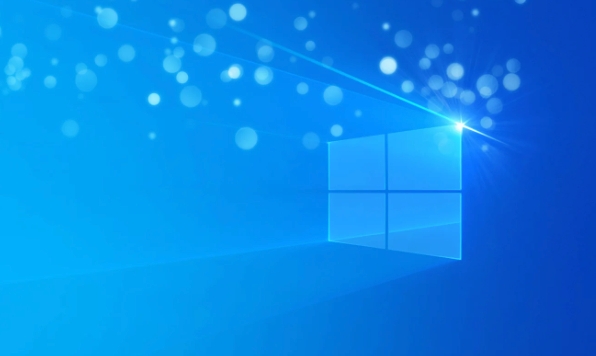Windows 10 audio sizzling problems are usually caused by system settings, drivers, or connection methods, rather than hardware damage. Solutions include: 1. Check the headset or speaker connection, try plugging, replacing the device, or reconnecting Bluetooth; 2. Update or rolling back the audio driver, which can be manually updated or operated through the Device Manager; 3. Disable Windows Audio Enhancement to reduce interference; 4. Turn off the "Allow computer to turn off this device to save power" option to keep power stable. After sequential investigation, most problems can be solved. If they are invalid, consider replacing the hardware or reinstalling the system.

The sizzling audio on Windows 10 is really annoying, especially when you suddenly have noises when you listen to music, have meetings or play games. This problem is usually not that the hardware is broken, but that there is something wrong with the system settings, drivers or connection methods. Below are some common reasons and corresponding solutions, which can be basically solved by checking them.

Check headphones/speakers and cables
The easiest way is often effective. First, troubleshoot whether the headphones themselves are:

- Plug and unplug the headphones to ensure good contact with the interface
- Change the headset to see if there is any abnormality
- If it is a Bluetooth headset, disconnect and reconnect once
- If you have a USB sound card or external speaker, try changing to a USB port
Sometimes it is just loose or there is a problem with an interface, and you can restore normality by reconnecting it.
Update or rollback audio drivers
One of the most common reasons for the audio driver is problematic. You can check for updates manually or automatically update through Device Manager:

- Open Device Manager
- Expand "Sound, Video, and Game Controllers"
- Right-click on your audio device (such as Realtek High Definition Audio)
- Select "Update Driver"
If there is a noise after the driver has been updated recently, you can also try "rollback the driver" and return to the previous stable version.
In addition, you can also download the latest official driver installation on the motherboard or laptop brand official website.
Adjust Windows Audio Enhancements
Windows has some audio enhancements, such as space sound effects, equalizers, etc., which can sometimes cause sound instability:
- Open Sound Settings → Sound Control Panel
- Double-click the output device currently in use
- Switch to the Enhanced tab
- Check "Disable all enhancements"
This operation will not affect the sound quality too much, but it can avoid some unnecessary interference and noise.
Turn off "Allow the computer to turn off this device to save power"
This hidden setting can sometimes affect the stability of the audio device:
- Back to Device Manager
- Find your audio device, right-click → Properties
- Switch to the Power Management tab
- Uncheck "Allow the computer to turn off this device to save power"
This allows the system to maintain continuous power supply to the audio equipment and avoid sound interruptions or noise caused by power-off restarts.
Basically these commonly used methods. You can try it in order and in most cases you can find the reason. If you try it all but it doesn't work, you may have to consider replacing the headphones, sound card or reinstalling the system.
The above is the detailed content of How to fix audio crackling in Windows 10. For more information, please follow other related articles on the PHP Chinese website!

Hot AI Tools

Undress AI Tool
Undress images for free

Undresser.AI Undress
AI-powered app for creating realistic nude photos

AI Clothes Remover
Online AI tool for removing clothes from photos.

Clothoff.io
AI clothes remover

Video Face Swap
Swap faces in any video effortlessly with our completely free AI face swap tool!

Hot Article

Hot Tools

Notepad++7.3.1
Easy-to-use and free code editor

SublimeText3 Chinese version
Chinese version, very easy to use

Zend Studio 13.0.1
Powerful PHP integrated development environment

Dreamweaver CS6
Visual web development tools

SublimeText3 Mac version
God-level code editing software (SublimeText3)
 Why does the computer lose its sound?
Feb 18, 2024 pm 08:36 PM
Why does the computer lose its sound?
Feb 18, 2024 pm 08:36 PM
Why does the computer have no sound? In recent years, the computer has become one of the indispensable and important tools in people's lives. Whether it is office work, study or entertainment, we almost all need to rely on computers. However, occasionally we encounter a very distressing problem, that is, the computer suddenly has no sound. This problem will not only affect our listening enjoyment, but may also prevent us from using some necessary functions, such as video calls or audio playback. In this article, we’ll explore some common causes, and ways to fix the problem
 How to fix audio crackling in Windows 10
Jul 07, 2025 am 01:40 AM
How to fix audio crackling in Windows 10
Jul 07, 2025 am 01:40 AM
Windows 10 audio sizzling problems are usually caused by system settings, drivers, or connection methods, rather than hardware damage. Solutions include: 1. Check the headset or speaker connection, try to plug, unplug, replace the device, or reconnect Bluetooth; 2. Update or roll back the audio driver, which can be manually updated or operated through the Device Manager; 3. Disable Windows Audio Enhancement to reduce interference; 4. Turn off the "Allow computer to turn off this device to save power" option to keep the power supply stable. After sequential investigation, most problems can be solved. If they are invalid, consider replacing the hardware or reinstalling the system.
 How to fix 'No audio output device is installed' on Windows
Jul 02, 2025 am 10:24 AM
How to fix 'No audio output device is installed' on Windows
Jul 02, 2025 am 10:24 AM
When you encounter the "Noaudiooutputdeviceisinstalled" prompt, it means that Windows has not detected an audio device, and the problem is usually caused by the driver, settings, or hardware. 1. First check the sound settings and confirm whether the default playback device is correct and whether the volume is not muted; 2. Enter the device manager to update or reinstall the audio driver, and manually download and install it if necessary; 3. Run the Windows Sound Troubleshooting Tool to automatically troubleshoot problems; 4. Check the connection status of the external audio device, try to replace the headset or use a USB sound card to troubleshoot hardware failures. In most cases, it can be solved by setting the default device or updating the driver. If it still cannot be processed, it may be due to system files corruption or hardware problems. The system needs to be repaired or contacted further.
 How to fix 'No audio output device is installed' in Windows?
Jun 30, 2025 pm 03:59 PM
How to fix 'No audio output device is installed' in Windows?
Jun 30, 2025 pm 03:59 PM
When encountering the problem of "No audio output device installed", first check and update the audio driver, open the Device Manager to view the status of the sound device, right-click to update the driver or manually download and install it; secondly, check whether there are disabled audio devices, right-click to enable and confirm whether the playback device appears in the sound settings; then run the audio troubleshooting tool that comes with the system for automatic detection and repair; in addition, you can try restarting the Windows Audio service, checking system updates, confirming that the audio function in the BIOS is enabled, and eliminate interference from external devices, unplug the audio or headset to test different interfaces. Follow the above steps to check in turn, and in most cases, the problem can be solved.
 How to fix a 'No speakers or headphones are plugged in' error in Windows
Jul 30, 2025 am 04:46 AM
How to fix a 'No speakers or headphones are plugged in' error in Windows
Jul 30, 2025 am 04:46 AM
First check the physical connection, re-plug and unplug the device and test different ports or devices to troubleshoot hardware problems; 2. Run Windows Audio Troubleshooting to automatically fix common problems; 3. Enable and set the playback device to the default output in the sound settings; 4. Update, reinstall or manually install the latest audio driver through the Device Manager; 5. Realtek users need to enable the audio jack detection function in the audio control panel; 6. Enter the BIOS if necessary to ensure that the onboard audio controller is enabled; 7. Finally, you can restart the Windows Audio Service Quick Recovery function. In most cases, this problem is caused by driver or setting errors, and you can solve it by following the steps.
 Remote Desktop audio not working
Jul 11, 2025 am 01:11 AM
Remote Desktop audio not working
Jul 11, 2025 am 01:11 AM
Audio does not work properly when connected to remote desktop, usually a setup or configuration problem. 1. You need to check whether audio redirection is enabled. Select "Play sound and record" in the "Local Resources" tab of the remote desktop client. 2. Make sure that the correct audio output device is selected on the remote side, right-click the volume icon to enter "Sound Settings" to adjust the default playback device. 3. Check whether the WindowsAudio and RemoteDesktopServicesAudioRedirector services are running, start and set to automatic if necessary. 4. Update or reinstall the audio driver of the remote computer, operate it through the device manager or manually install the latest driver. 5. Group policy is required in an enterprise environment to ensure that "audio re-response is not allowed"
 Why is my WhatsApp audio not working
Jul 31, 2025 am 05:15 AM
Why is my WhatsApp audio not working
Jul 31, 2025 am 05:15 AM
First check the volume and mute settings of the mobile phone media to ensure that the virtual headset is not connected; 2. Restart, update or reinstall WhatsApp app; 3. Android users can clear the application cache; 4. Ensure the network connection is stable; 5. Check whether the microphone and storage permissions are turned on; 6. Test whether the device speaker is normal; 7. Troubleshoot the WhatsApp server problem, contact official support if necessary, and the problem can usually be solved through gradual troubleshooting.
 Premiere Pro audio crackling
Aug 03, 2025 pm 12:57 PM
Premiere Pro audio crackling
Aug 03, 2025 pm 12:57 PM
The problem of clicking or popping sounds in PremierePro audio can be solved by the following methods: 1. Ensure that the audio sample rate is consistent with the project settings, use Audition to check and convert the format before importing, or change the hardware output source to ASIO in the preferences; 2. Render preview audio or reduce the playback resolution, turn off unnecessary audio plug-ins to reduce the load; 3. Update the sound card driver, switch the audio device to the default device for Windows or check the conflicts of Mac audio equipment, and try to use headphones to eliminate hardware interference; 4. Select the appropriate encoding and bit rate during export, such as AAC encoding, 48kHz sampling rate, and bit rate above 192kbps to avoid platform decoding compatibility issues.






